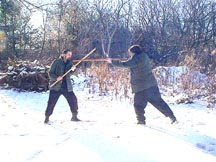A la baionnette! V.
This is coolbert:
"If you are fearful, never learn any art of fighting"
- Master Liechtenauer, c.1389
- Master Liechtenauer, c.1389
Here are an assortment of web sites that describe and illustrate bayonet fencing from the period of the American Civil War and World War One. American Civil War reenactors taking things very seriously. I have a suspicion that soldiers of that period spent a lot of time in bayonet practice, even if the "cold steel" was seldom used.
19th Century American Bayonet Fencing

7 Key Techniques of Bayonet Fencing

Bayonet fencing is described as - - "the mysterious '4th Form' of Fencing!"
The Training Bayonet 1858-1912 - - Bayonet History American

The illustration above shows two American Federal troops [Zouaves] training with the bayonet. Some sort of hard rubber ball was placed on the tip of the bayonet so as not to stick the other troop. Makes sense. Butt strokes were not considered "legal"?
Please note the various uses of fencing terms to describe bayonet fencing moves as practiced during the American Civil War. High Quarte - - High Tierce, Quarte - - Tierce, Prime - - Seconde, In-Quartada. Terms that would have been used in the Italian school of fencing?
And here is a web site describing how Canadian troops of the World War One era were taught combatatives. Beginning with boxing and proceeding to bayonet fencing. The footwork, arm, and body movements with both being similar?
"Boxing for Beginners, with Chapter showing its 'Relationship to Bayonet Fighting"
"It has long been recognized in the army that good boxers make good bayonet fighters."
"The object of the boxing was twofold . . . Many qualities had to be developed and developed quickly. Physical courage is perhaps the most common of virtues, but the courage needed in the soldier, and especially in the bayonet fighter, is a courage born of confidence and ability to fight and to defend himself. I do not believe there is any other form of exercise which develops this as quickly as the practice of boxing. Secondly, and fortunately, bayonet fighting is so near akin to boxing that the practice of boxing develops skill in bayonet fighting in less time, with less expense, and with fewer casualties."
"Major Nobbs [Canadian] has had a great deal of experience as an athlete, boxed in the semifinals at his university, was a good cross-country runner and a champion swordsman. When the war broke out [in 1914] he was professor of architecture at McGill University and went to England to join the Imperial Army. His work was of such high order that he was sent out to the Canadian Forces to take charge of bayonet fighting and physical training. He is a worker and a fighter."

[The Major was a pretty remarkable person. NOT a college professor who was a dilettante or an effete'. The foot movements of fencing and boxing are similar to one another? The foot movements of bayonet fencing also similar as well to boxing and fencing?]
"ef·fete adj.
Marked by self-indulgence, triviality, or decadence: an effete group of self-professed intellectuals. Overrefined; effeminate."
"dil·et·tante adjective
–noun 1. a person who takes up an art, activity, or subject merely for amusement, esp. in a desultory or superficial way; dabbler."
coolbert.
Labels: Bayonet

0 Comments:
Post a Comment
Subscribe to Post Comments [Atom]
<< Home